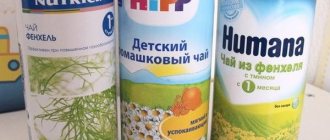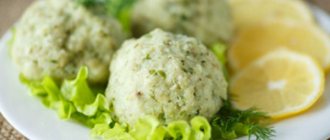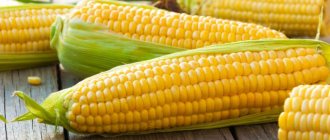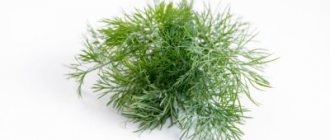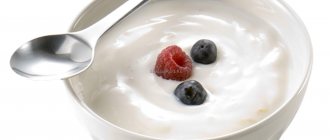At what age can you give your child sausages?
Of course, a child eats sausages with pleasure, but parents should not recklessly stuff their child with them beyond measure. This must be done carefully and thoughtfully. Parents are often concerned about the question of whether their children can have sausages at all, and at what age should they start giving them? Pediatricians definitely recommend offering such products to a child for the first time at the age of 2.5-3 years. Under no circumstances should you feed them to infants and especially newborns.
Products given to children must have all the signs of naturalness, without even the slightest suspicion of the presence of soy and spices. The salt content should also be very limited. Preference is given to boiled sausages. Smoked and semi-smoked sausages are allowed to be given to children from 5-7 years old.
At first they give a very small amount. At the same time, the response of the child’s body is observed. It is better not to give sausages to a 1-year-old child at all. The answer will be the same if mothers are interested in whether it is possible to give sausages to a 2-year-old child.
There should be no more than 200 g of such a product in the diet per day, and it should be given no more than twice a week. It is better if the sausages are accompanied by a side dish.
Answers to frequently asked questions
What to do if the child does not eat anything except sausages, what can be replaced? Offer natural meat dishes instead. If your baby refuses them and demands sausages, prepare them yourself from high-quality, age-appropriate ingredients.
A child ate a sausage with cling film: is it dangerous? Food film is considered a foreign object and is not digested in the gastrointestinal tract. In most cases, undigested residues are eliminated naturally. Therefore, it is recommended to keep an eye on your stool.
Attention! If you experience abdominal pain or no bowel movements for more than two days, take your baby to a specialist for examination.
What to do if a child eats expired sausages? This may cause food poisoning. When the first signs of illness appear (stomach pain, vomiting, diarrhea), visit a doctor immediately. Do not try to treat yourself!
Can children eat raw sausages? Frankfurters, unlike sausages, are a meat product that requires mandatory heat treatment. So no, you can't.
Is it allowed to give in kindergarten? In accordance with SanPiN 2.4.1.3049–13, sausages, sausages, and children’s boiled sausages are acceptable on the menu of preschool institutions. But no more than 1-2 times a week. Before serving, they must undergo mandatory heat treatment.
What kind of sausages can be given to children?
Regardless of the variety, the product must be of high quality. The best product will be one that contains chopped natural meat. Sausages according to GOST 31498-2012 differ in composition, which is represented by meat, milk, and bacon. The amount of spices should be minimal, and as for children, it is better if they are absent altogether.
Please keep in mind that sausages have a limited shelf life. As a rule, it does not exceed 7-10 days.
The child’s diet requires the exclusion of bacon, sausages, and pork products. This requirement is dictated by the fact that the digestive system of the child’s body is not yet sufficiently formed for such fatty foods. This information is the answer to the question of what kind of sausages children can eat.
Baby sausages: how to choose
In products for children, the list of ingredients should be as short as possible. According to GOST 31498-2012 “Boiled sausage products for baby food. Technical conditions" in the composition of children's semi-finished products should not contain anything other than meat, eggs, milk, bacon, salt and spices; flour, vegetables and cereals are allowed. The fat content should be minimal, the same goes for seasonings.
Additives marked “E” (enhancers, preservatives, stabilizers), starch, by-products, products of plant origin, and genetically modified components are excluded.
What kind of sausages can be given to children: “Milk”, “Creamy”, “Doctor’s”, made according to GOST. These sausages can be given to children under 2 years old with caution.
Semi-finished products for baby food are divided into 2 categories: for children 3-6 years old (preschoolers) and 6-14 (schoolchildren). Per 100 g of product, the weight of protein should not exceed 12 g, fat - 22 g. The meat base is chicken, turkey or beef. According to the rules, the meat content is at least 60%. Pork products and those with a high fat content (sausages, bacon) are excluded, as they are too heavy for the baby to digest.
Women who are breastfeeding should follow the same rules for choosing foods. Unwanted components can enter the baby's body with milk and cause harm to him.
The color of a quality sausage product is grayish-pink, neutral and uniform. Bright pink sausages definitely contain large amounts of sodium nitrite. The same applies to the smell: an overly pronounced aroma is a sign of a flavor enhancer in the composition.
The right choice of sausages
In order for the child’s body not to suffer from eating sausages, you need to learn how to choose them correctly:
• You should buy only those products that are of the highest quality, and production is carried out in accordance with the requirements of the state standard.
• It is better to buy those products that have not been manufactured for more than a day.
• The sausage casing must be natural. You should not buy sliced sausage.
• Natural high-quality products should have a slightly pink color.
• The cut should have a uniform color.
• The product should not be overly elastic. If such a moment is present, then this indicates the presence of a large amount of gelatin.
• It is better for children to consume products based on beef.
• Homemade sausages are the safest option.
Sausages: what are they made of?
Meat dishes serve as a source of substances necessary for humans - proteins, calcium, iron and a number of vitamins, the lack of which leads to retardation in physical and mental development. However, sausages are not a product identical to natural meat; they are inferior in nutritional value and, in addition, contain a number of additives, in particular preservatives.
All sausages are classified depending on the type of raw materials and technological processing: pork, beef, dairy, although these designations, in fact, are only a commercial name, since the raw materials they contain are usually mixed. Little ones who love pink, fragrant sausages so much can be given them once or twice a week starting from the age of one and a half years. For babies, only specialized children's sausages are recommended, which are qualitatively different from ordinary ones. In children's sausages, all components are strictly regulated - they contain much less fat (in ordinary sausages the amount of fat ranges from 2/3 to half), nitrates and table salt. Children's products are strictly tested for the presence of toxic elements, antibiotics and pesticides.
Back to contents
Is it necessary to buy sausages?
There is an alternative to store-bought sausages and sausages - these are meat products prepared with your own hands from homemade products. Such food is definitely healthier and tastier than store-bought food. Housewives have collected a large collection of recipes for making homemade children's sausages.
It happens that the baby does not want to eat semi-finished food. Tricks that loving parents use include interesting dish design. It is enough to present sausages beautifully for children, and breakfast, lunch or dinner becomes a holiday.
Before giving sausages to children, you should think about their benefits. Creating a children's menu is not an easy task: children must not only receive all the necessary nutrients, but also eat with appetite. Many children love sausages, but the choice of such products should be treated very carefully.
There are a few commandments to remember:
- You can give your child sausages from the age of 2-3 years, but very rarely.
- Products are selected strictly according to GOST,
- You should definitely try sausages and sausages and carefully monitor the reaction of the child’s body.
In many families, sausage, frankfurters or sausages often appear on the table. But can these products become an alternative to meat dishes on the children's menu? Pediatricians never tire of repeating that small children need meat for proper growth. It serves as a source of important nutrients - protein, calcium, iron, a number of vitamins and amino acids, the lack of which can lead to serious health problems and retardation in physical and mental development. And therefore, no one has any questions about the advisability of feeding a baby chicken or beef fillet.
But not all mothers know how to treat sausage products in their baby’s diet. Despite the fact that today you can find a huge selection of sausages and sausages on sale: manufacturers focus on literally every taste, for every income.
Some sausages are even labeled “for children.” But are such products really suitable for small children to eat? And if so, at what age can you treat your baby to a sausage for the first time and how often is it acceptable to do this?
To understand whether sausage can be replaced with a natural meat dish, you just need to read the list of ingredients on the product packaging. You will be unpleasantly surprised by a rather long list of items, which necessarily includes various additives, spices, salt and, of course, preservatives.
It is thanks to the additives that sausage meat products have a particularly attractive aroma and rich taste, as well as an appetizing appearance and pleasant texture. All this is given to sausages and sausages by carrageenan (a thickening agent obtained from algae), sodium and potassium nitrate, pyrophosphates and carminic acid, or cochineal, extracted from insects. There are really too many of these substances in sausages. But there is almost no real meat there.
According to the standard established in our country, sausages and sausages must contain at least 10% meat. And some unscrupulous manufacturers believe that this amount is quite enough. But even in the most expensive sausage, the meat content may not exceed 50%, and there will be a lot of preservatives and all kinds of additives - just like in other, cheaper varieties.
So what is included in regular “adult” sausages and sausages? Usually this is soy, pork skin, tendons, fat, some meat, as well as the above artificially obtained compounds. Their quantity and quality are also solely at the discretion of the manufacturer. For example, carrageenan in minimal doses is safe for health. But very often it is added to products in large quantities to increase the specific gravity of minced meat. And the increased content of this additive in sausages can cause not only allergies and diathesis in children, but also serious food poisoning.
Children's sausage
The composition of sausages and sausages convinces us that there is really little benefit from them. Therefore, experts recommend that parents introduce their children to such products as late as possible. And use only the special, children's category of this type of product.
To be fair, it is worth noting that the so-called children's sausage (or sausages) still differ in composition from the adult one. Children's semi-finished products contain much less fat (in regular sausages their amount ranges from 2/3 to 1/2 of the total volume), nitrates and salt. Also, products intended for the younger generation are strictly tested for the presence of toxic substances, antibiotics and pesticides.
So if your family loves sausages, and the baby’s hands are increasingly reaching for the parent’s plate, it is better to buy products for the little gourmet that are aimed at his age category.
But doctors do not recommend giving even this to children younger than one and a half years old. And it is not recommended to feed children under the age of three adult sausages and sausages, because until that time the child’s body is not able to cope with so many food additives and fats.
Sausage benefits
Realizing all the “unhealthiness” of sausages, many parents, however, cannot completely give them up. A sandwich with doctor's sausage or boiled sausages in the morning - for most families this is a quick and nutritious breakfast option. And if this is also customary for you, try to at least partially make your meals healthy. For example, instead of two sausages, use one, serving it with a side dish of boiled vegetables or buckwheat.
It is also worth considering that sausages and sausages can only be consumed in heat-treated form. And to prevent them from boiling, you need to pierce them with a fork in several places before putting them in boiling water. By the way, this will also help get rid of excess fat during cooking.
Please note that sausages are perishable products. Even if they are packaged in a natural shell, the shelf life does not exceed three days. In open packaging they can be kept in the refrigerator for no more than a day, and in vacuum packaging - no more than a week.
Usually sausage or frankfurters are eaten for breakfast. But your morning meal can be delicious without them. Doesn't the toddler like porridge? There are many types of cheese, cottage cheese products, egg dishes, pancakes, cereals and muesli...
And let sausage and frankfurters be on your table no more than once a week.
Doctor's opinion
It is not recommended for a child under one and a half years old to even try sausages. The reason is not only a large number of additives, dyes and preservatives. The fact is that sausages and sausages have a richer taste than natural meat dishes. And by regularly eating them, a child may end up giving up real meat. Only after half a year or two years are children allowed to occasionally consume this type of product, but only special children's products. When purchasing, pay attention to the label stating that the product is recommended for feeding preschool children or that it has passed the hygienic examination of the Research Institute of Nutrition of the Russian Academy of Medical Sciences.
Parents should also keep in mind that these products should not be included in the menu of children prone to obesity, allergic reactions and gastrointestinal diseases. But even a healthy child, despite the attractive taste and ease of use of this type of product, is not recommended to consume it more than once a week. It is better to prepare natural meat dishes for the whole family, as they contain a lot of useful substances and are easier to digest by the body. Children's nutritionists impose a strict ban on smoked, dried or raw smoked sausages - they are contraindicated for children under 7 years of age.
A small child should not even be given a piece of smoked sausage to chew, as there are even more harmful additives there than in boiled sausage. All “adult” sausages and small sausages (these two types of products differ only in appearance) are divided into pork, beef, chicken and dairy. In fact, all these definitions, in fact, are just a commercial name, because the raw materials they contain, as a rule, are approximately the same - mixed.
The functioning and development of a child’s body directly depends on the organization of baby food.
Young parents love to pamper their babies with all sorts of goodies, the harm of which they either do not suspect or prefer not to think about. A taboo is imposed on a number of products, including sausages, canned food, mayonnaise, chocolates, semi-finished products, glazed cheeses, cakes, candies, frozen vegetables, ketchup, potato chips. Many of the listed products should be excluded from the diet of an adult. Unfortunately, most families eat unhealthy food. What is the harm of familiar products?
Sausages and sausages
Children love sausages and sausages! But sausages, sausages and sausages are dangerous due to their composition. After all, skins, lard, fat, and various meat production waste are often placed in them along with meat. The darker the sausage, the more of these additives it contains. Smoked sausage contains the most nitrites and nitrates. Therefore, it is strictly forbidden to give smoked sausage to children! An increased dose of nitrites and nitrates in products (including sausages) leads to poisoning of the body, damage to the entire gastrointestinal tract, liver, kidneys, and general intoxication; it can also become one of the reasons for the development of oncology. A large percentage of manufactured sausage products contain transgenic soybeans, flavors, dyes and flavoring additives.
If buying sausages and boiled sausage for your child is a big necessity, then you should only choose those products that are produced specifically for children. When purchasing, you should read the ingredients. Sausages or sausage must be boiled before use. These foods should be given to young children no more than three times a week.
Potato chips
Potato chips are bad for everyone, but especially for children. In addition to the composition, which is replete with taste improvers and flavorings, the harm lies in the manufacturing process itself. They are fried in a huge amount of fat, mostly overcooked many times. The harm to the stomach is obvious! The harm from French fries is similar.
Seafood
Not all seafood is harmless enough for kids. Some of them may cause allergic reactions. For example: shrimp, squid, lobster, caviar, red fish, seaweed and others. Seafood contains quite a lot of cholesterol, and salted foods contain table salt. All these substances can disrupt water-salt metabolism in the body. Smoked fish is especially harmful for children. Often fish is smoked using a special composition that is far from harmless to the body. Having eaten such fish, a child can get severe poisoning.
Fresh fish can also be dangerous: there is a possibility that it is infected with helminths and salmonella. In any case, you need to buy fish after checking the quality certificate. During the cooking process, fish must undergo good heat treatment.
Eating seafood is allowed for children no earlier than six years of age.
Sweet carbonated drinks
Carbonated drinks sometimes pose a great danger, since the most natural thing in their composition is only water, and the rest is either a mystery of nature or the complete composition of the periodic table. For example, Pepsi-Cola and its analogues. Even the most seemingly harmless carbonated drinks are harmful because they irritate the gastric mucosa. In addition, they contain a lot of sugar, which can cause obesity. It is better to replace the drink with baby water, which contains the necessary minerals.
In addition to preservatives, flavorings, dyes and vinegar, this product contains modified starch and monosodium glutamate. Monosodium glutamate is a food additive found in many canned and processed foods. It is used as a flavor enhancer. In Japan, studies were conducted on experimental rats. Experiments have shown that as a result of taking large doses of monosodium glutamate in rats, vision deteriorated.
There are many healthy homemade ketchup recipes that include fresh tomatoes, salt, sugar and starch (for thickening). This ketchup is much tastier and healthier than store-bought ketchup, plus you can offer it to your baby.
Exotic fruits
Exotic fruits are not recommended for small children in large quantities, as an allergic reaction may occur. They should be given to children carefully, in very small quantities. Young parents should be sure to monitor the body’s reaction during the initial intake.
No matter how hard you try to protect your baby from sausages, he will still try them. If they periodically appear on your table, then they will naturally interest the baby.
The store sells sausages stamped “for children.” But is this product really suitable for feeding small children?
And if so, at what age can a child have sausages? Having weighed the benefits and harms of this product on the child’s body, it will be easier for you to decide whether to include sausage in the children’s menu.
Sausages in baby food
Currently, Russian pediatricians propose to include in the menu of young children specially developed children's varieties of sausages, which have passed a hygienic examination at the Nutrition Research Institute of the Russian Academy of Medical Sciences. The product must bear a mark stating that it is recommended for feeding preschool children.
Sausages can be offered as an independent dish, or with a side dish, preferably vegetables - zucchini, potatoes, beets, carrots. But it is better not to allow the combination with pasta, which is beloved by all kids, to avoid excessive carbohydrate load. And do not forget that before you feed your little one with sausages, you must subject these products to heat treatment.
In addition to sausages, children’s boiled sausages, which are practically no different in composition from sausages, can also be introduced into a child’s diet.
Back to contents





